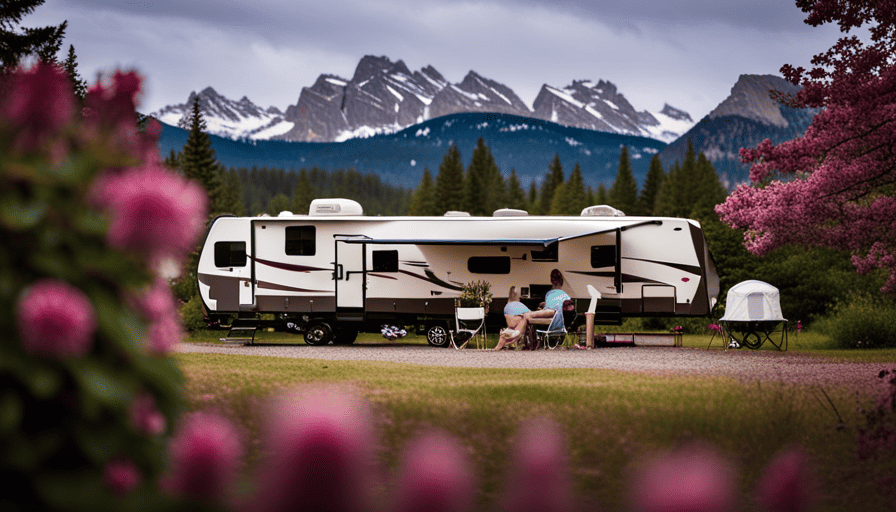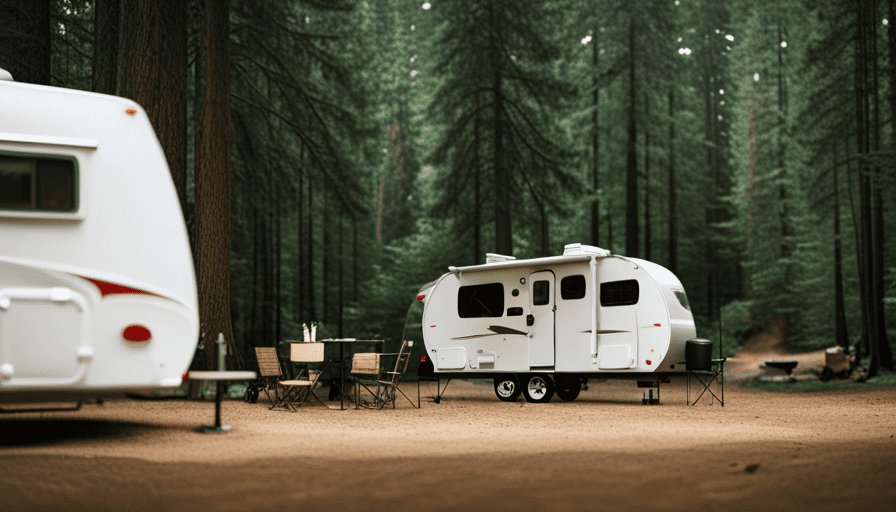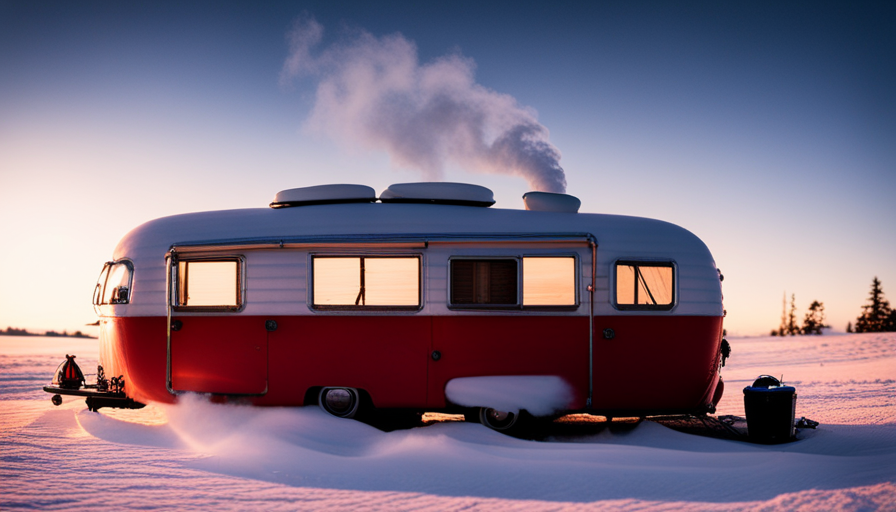Are you prepared to liberate your fifth wheel camper from its frosty captivity and set off on an exciting journey?
Well, hold on to your seats because I’m about to reveal the ultimate guide on how to de-winterize your beloved home on wheels! Get ready to witness a transformation like no other as we bring your camper back to life, ready to hit the open road.
From draining and flushing the water system to testing and inspecting appliances, we’ll leave no stone unturned in ensuring your camper is in top-notch condition.
But wait, there’s more! We’ll also check safety equipment and even help you plan your next exhilarating journey.
So buckle up, my fellow adventurers, because it’s time to de-winterize your fifth wheel camper and let the wild expedition begin!
Key Takeaways
- Properly draining and flushing the water system is essential to prevent damage and maintain water quality.
- Regularly inspecting and cleaning the exterior of the camper, including seals and awning, helps ensure its longevity.
- Testing and charging the batteries is crucial for optimal electrical system performance.
- Organizing and decluttering the interior living area maximizes space and creates a comfortable environment for travel.
Prepare Your Tools and Supplies
Get ready to de-winterize your fifth wheel camper by gathering all the necessary tools and supplies! Before you begin, it’s essential to ensure that your tools are in good condition. Check for any rust, damage, or worn-out parts. Tool maintenance is crucial for a successful de-winterization process. Additionally, make sure you have the appropriate safety equipment, such as gloves and safety glasses, to protect yourself during the task.
Once you have your tools and safety gear ready, it’s time to move on to the next step: drain and flush the water system. This is an important process as it removes any stagnant water and prevents any potential damage caused by freezing temperatures.
To start, locate the drain valve and attach a hose to it for easy water disposal. Open the valve and allow all the water to drain out completely. After draining, close the valve and proceed to flush the system. This can be done by connecting the fresh water hose to the city water inlet and turning on the water supply. Let the water run through all the faucets, showerheads, and toilets until it flows clean and clear.
By properly preparing your tools and supplies and following safety precautions, you’re now ready to drain and flush the water system.
Drain and Flush the Water System
Start by draining and flushing your water system to prepare for the upcoming season. Flushing techniques are crucial for maintaining the cleanliness and functionality of your water system.
To begin, locate the drain valve, usually found near the bottom of the water tank. Attach a hose to the valve and direct the other end to a suitable drainage area. Open the valve and let the water flow out completely. This step will remove any stagnant water and prevent the growth of bacteria or mold.
After draining the water tank, it’s essential to flush the system to ensure all residual debris is removed. Start by closing the drain valve and filling the tank with fresh water. Open all faucets, including hot and cold water, allowing the water to run for several minutes. This process will help flush out any remaining contaminants. Repeat this step a few times until the water runs clear.
Once you have thoroughly flushed the water system, it’s time to move on to the next section about checking and replacing filters. This step ensures that your water will be clean and safe for use throughout the season.
Check and Replace Filters
To ensure clean and safe water for your upcoming adventures, don’t forget to check and replace the filters in your water system. Filters play a crucial role in maintaining the quality of the water that flows through your fifth wheel camper.
Over time, these filters can become clogged and less effective, which can lead to impurities and contaminants in your water supply. By regularly replacing the filters, you can ensure that your water system functions optimally and provides you with clean and healthy water.
To replace the filters, first, locate the filter housing in your camper. This is usually found near the water pump or the point where the water enters the system. Carefully remove the old filter and dispose of it properly. Then, install a new filter by following the manufacturer’s instructions. Make sure to tighten it securely to prevent any leaks. Once the new filter is in place, turn on the water system and check for any signs of leakage.
By regularly checking and replacing the filters in your water system, you can maintain the quality of your water and provide a healthy environment for your adventures.
Now that the water system is in good condition, it’s time to move on to the next step: inspecting and cleaning the exterior of your fifth wheel camper.
Inspect and Clean the Exterior
After replacing the filters, it’s important to inspect and clean the outside of your camper. This step is crucial in ensuring that your fifth wheel camper is ready for use after being winterized.
Start by inspecting the seals around the windows, doors, and compartments. Look for any signs of wear or damage, such as cracks or gaps. If you notice any issues, it’s important to repair them as soon as possible to prevent water leaks during your trips.
Next, thoroughly clean the exterior of your camper. Use a mild detergent and a soft brush to remove any dirt, debris, or grime that may have accumulated during the winter months. Pay special attention to the roof, as leaves and other debris can get trapped there and cause damage over time. Inspect the awning for any tears or holes and clean it using a specialized awning cleaner.
Lastly, check the condition of the tires and ensure they’re properly inflated. Inspect the hitch and make sure it’s in good working condition. Once you’ve completed these tasks, you’re ready to move on to the next step: testing and charging the batteries.
Transitioning to the next section, it’s important to make sure your batteries are in optimal condition before hitting the road.
Test and Charge the Batteries
Now, it’s time to ensure your batteries are in their best condition by testing and charging them. Proper battery maintenance is crucial for the overall performance of your fifth wheel camper’s electrical system. Before you begin, make sure to disconnect any power sources and turn off all appliances. To test the batteries, you will need a multimeter or a battery tester.
Start by measuring the voltage of each battery using the multimeter. A fully charged battery should read around 12.6 volts. If the voltage is significantly lower, it may indicate a problem with the battery’s charge. Next, check the battery terminals for any signs of corrosion or loose connections. Clean the terminals with a mixture of baking soda and water, and tighten any loose connections.
If the batteries are low on charge, it’s time to recharge them. Connect the charger to a power source and attach the positive and negative cables to the corresponding terminals of each battery. Follow the manufacturer’s instructions for the specific charger you are using. Once the batteries are fully charged, disconnect the charger.
To ensure the batteries are performing optimally, you can also perform an electrical system troubleshooting. Test the camper’s lights, appliances, and other electrical components to ensure they are functioning properly. If you encounter any issues, consult the owner’s manual or seek professional help.
With the batteries tested and charged, it’s time to move on to the next step: checking and inflating the tires.
Check and Inflate Tires
Make sure you give your tires some TLC and check their pressure before hitting the road – it’s like giving your camper’s feet a good stretch!
Inspecting tire pressure is an essential part of maintaining your fifth wheel camper. Start by visually inspecting the tires for any visible signs of wear and tear, such as cracks or bulges. These can indicate potential issues that need to be addressed before you start traveling.
Next, use a tire pressure gauge to check the air pressure in each tire. Properly inflated tires are crucial for safe and smooth travel. Refer to the manufacturer’s recommendations for the correct tire pressure. If the pressure is low, use an air compressor to inflate the tires to the recommended level.
It’s also a good time to inspect the tread depth, as worn-out tread can affect traction and handling. Additionally, make sure to check the lug nuts for tightness and ensure they’re properly torqued.
Tire maintenance tips like these will help ensure a safe and comfortable journey. Now that your tires are in top shape, it’s time to clean and organize the interior of your fifth wheel camper.
Clean and Organize the Interior
Ensuring a clean and organized interior is key to maximizing your comfort and enjoyment while traveling in your fifth wheel camper.
To start, decluttering is essential for creating a spacious and efficient living area. Begin by removing any unnecessary items and finding proper storage solutions for the essentials. Utilize bins, baskets, and organizers to keep things tidy and easily accessible. Consider implementing space-saving tools like hanging shoe racks or collapsible storage containers.
Next, focus on the interior design of your fifth wheel camper. Choose a color scheme that reflects your personal style and creates a calming atmosphere. Opt for lighter shades to make the space feel more open and airy. Incorporate soft furnishings, such as throw pillows and blankets, to add warmth and coziness. Consider installing blackout curtains to block out unwanted light and provide privacy during your travels.
Additionally, maximize storage space by utilizing every nook and cranny. Use under-bed storage containers, over-door hooks, and hanging shelves to make the most of vertical space. Keep the kitchen organized by using drawer dividers and labeled containers for spices and utensils. Install wall-mounted racks to hang pots, pans, and cooking tools.
By decluttering and implementing thoughtful interior design ideas, your fifth wheel camper will become a comfortable and inviting home away from home.
Transitioning into the next section, it’s important to test and inspect all appliances before hitting the road.
Test and Inspect Appliances
Before taking off on your adventure, be sure to test and inspect all appliances to ensure they’re in proper working order, providing you with a worry-free journey. Appliance maintenance is crucial for a smooth and enjoyable camping experience. Here are three key steps to follow for testing and inspecting your fifth wheel camper’s appliances:
-
Check the propane system: Start by inspecting the propane tanks and hoses for any signs of damage or leaks. Ensure the tank valves are closed before inspecting the connections. Test the propane stove, oven, and refrigerator to make sure they’re functioning properly. Additionally, check the carbon monoxide and propane detectors to ensure they’re operational.
-
Test the electrical system: Inspect the electrical cords and connections for any signs of wear or damage. Check the power outlets and make sure they’re working correctly. Test the lights, fans, air conditioning, and heating systems to make sure they’re functioning as expected. Don’t forget to test the microwave, TV, and other electronic devices as well.
-
Inspect the water system: Start by checking the water tanks and hoses for any leaks or damage. Test the water pump and faucets to ensure proper water flow. Check the hot water heater and make sure it’s working efficiently. Also, inspect the toilet, shower, and sinks for any leaks or plumbing issues.
Remember to follow safety precautions while testing and inspecting your appliances. Once you’ve completed these steps, you can proceed to the next section about checking safety equipment to ensure a safe and enjoyable camping trip.
Check Safety Equipment
Don’t forget to ensure your safety by checking all of your camping equipment. Safety equipment maintenance is essential before embarking on your next adventure in your fifth wheel camper. Regular safety checks are crucial to ensure that all equipment is in proper working condition and ready to be used.
Start by inspecting your fire extinguisher. Make sure it’s fully charged and easily accessible. Check the expiration date and replace if necessary.
Next, examine your smoke and carbon monoxide detectors. Test them to make sure they’re functioning properly and replace batteries if needed.
Inspect your emergency exit windows and make sure they open and close smoothly. Check the seals and make sure they’re intact to prevent any leaks.
Additionally, inspect your first aid kit and replenish any supplies that are running low or have expired.
Check your emergency road kit. Make sure it’s fully stocked with essentials like a flashlight, jumper cables, and a tire repair kit.
Regular safety equipment maintenance is of utmost importance to ensure a safe and enjoyable camping experience. Now that your safety equipment is in order, it’s time to plan your next adventure.
Plan Your Next Adventure
Get ready to hit the road and start brainstorming your next exciting camping adventure in your trusty RV! As the winter season fades away, it’s time to start planning your next travel destinations and gathering essential packing tips.
To make the most out of your de-winterizing process, here are four key things to consider:
-
Research Travel Destinations: Begin by researching the best travel destinations that align with your interests and preferences. Whether you’re drawn to picturesque landscapes, historic landmarks, or vibrant cities, there is a wide array of options to explore. Look for RV-friendly campsites, national parks, or scenic routes that offer breathtaking views along the way.
-
Plan Itinerary: Once you’ve chosen your travel destinations, create a detailed itinerary. Consider the distance between each location, the duration of your stay, and any must-see attractions or activities. This will help you stay organized and make the most of your time on the road.
-
Pack Efficiently: Packing efficiently is crucial to ensure you have all the necessary items without overburdening your fifth wheel camper. Make a checklist of essential items such as camping gear, cooking utensils, toiletries, and clothing for various weather conditions. Optimize storage space by using collapsible items and packing strategically.
-
Stock Up on Supplies: Before embarking on your adventure, stock up on supplies such as food, water, toiletries, and any other essentials. This will save you time and money by avoiding last-minute shopping trips during your journey.
By following these guidelines, you’ll be well-prepared to embark on your next unforgettable RV adventure. Happy travels!
Frequently Asked Questions
How often should the filters in a fifth wheel camper be replaced?
The filter replacement frequency for a fifth wheel camper depends on several factors, such as the quality of the filters and the usage of the camper. Generally, it’s recommended to replace the filters every 3 to 6 months or after every 10,000 to 12,000 miles of travel.
It’s important to choose the best filters for fifth wheel campers, such as high-efficiency filters that can effectively remove contaminants and ensure clean air and water inside the camper.
Can I use regular household cleaning products to clean the exterior of the camper?
Yes, you can use regular household cleaning products to clean the interior of the camper. However, it’s important to check the manufacturer’s guidelines to ensure that the cleaning products you’re using are safe for the specific surfaces in your camper.
As for using bleach to clean the exterior of the camper, it’s generally not recommended. Bleach can damage the finish and may cause discoloration. It’s best to use cleaning products specifically designed for RV exteriors.
How long does it typically take to drain and flush the water system in a fifth wheel camper?
Draining and flushing the water system in a fifth wheel camper typically takes about 30-45 minutes. First, I open all the faucets to release any remaining water.
Then, I locate the low point drains and open them to completely drain the system.
Next, I close the drains and connect a water hose to the city water inlet. I turn on the water and run it through each faucet until the water runs clear, ensuring a thorough flush.
What is the recommended frequency for testing and inspecting the appliances in a fifth wheel camper?
Testing and inspecting the appliances in a fifth wheel camper is crucial to ensure their proper functionality and safety. Experts recommend conducting these inspections at least once a year.
This frequency allows for early detection of any potential issues or malfunctions, preventing costly repairs or accidents down the road. Thoroughly checking the propane system, electrical components, water heater, stove, and other appliances will help maintain a smooth and trouble-free camping experience.
Are there any specific safety regulations or requirements that I should be aware of when using a fifth wheel camper?
When using a fifth wheel camper, it’s important to be aware of specific safety regulations and requirements. To ensure a safe experience, it’s recommended to follow a comprehensive maintenance checklist.
This includes inspecting and testing all appliances regularly, checking for any gas leaks, ensuring proper ventilation, and having functional fire extinguishers and smoke detectors.
Additionally, it’s crucial to adhere to weight restrictions, properly hitch the camper, and maintain the brakes and tires in good condition.
Are the Steps to De-Winterize a Fifth Wheel Camper the Same as a Regular Camper?
When it comes to de-winterizing a camper, the steps for a fifth wheel camper are generally the same as those for a regular camper. Both types of campers require flushing the water system, checking the plumbing and propane tanks, and inspecting the appliances. These steps ensure that the camper is ready for use after being winterized.
Conclusion
In conclusion, de-winterizing a fifth wheel camper is a crucial step in preparing for your next adventure. By following the steps outlined in this article, you can ensure that your camper is in top shape and ready to hit the road.
Did you know that, according to a recent survey, 85% of RV owners reported that de-winterizing their camper themselves saved them money compared to taking it to a professional? Taking the time to de-winterize your camper can not only save you money but also give you peace of mind knowing that everything is in working order.
So, grab your tools and get ready to enjoy the great outdoors!










